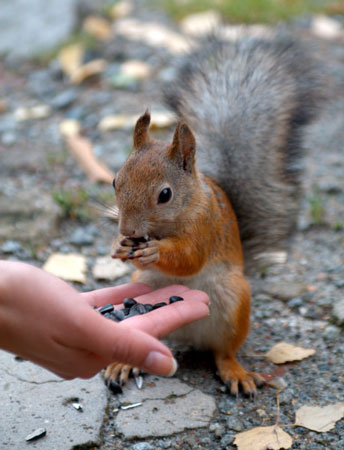Hello Boston! – Here’s Why You Have Squirrels!
By Chris Williams on April 14, 2014.
 Like most people, you probably thought that our city squirrels were country squirrels that packed a bag, headed for the bright lights, and decided to stay. The truth is that we the people introduced squirrels into our cities…on purpose. Way back in the 19th and early 20th centuries, city leaders in Boston, Philadelphia, and New York released squirrels in the hopes that they would thrive. Whether this intentional act makes you mad or glad says a lot about how you feel about squirrels.
Like most people, you probably thought that our city squirrels were country squirrels that packed a bag, headed for the bright lights, and decided to stay. The truth is that we the people introduced squirrels into our cities…on purpose. Way back in the 19th and early 20th centuries, city leaders in Boston, Philadelphia, and New York released squirrels in the hopes that they would thrive. Whether this intentional act makes you mad or glad says a lot about how you feel about squirrels.
Etienne Benson is one of the nation’s leading squirrel historians. That’s right, his latest research study concerns why and how we have squirrels in our cities. If you want all the details, check out his article, “The Urbanization of the Eastern Gray Squirrel in the United States” in the Journal of American History. When Benson dug through old newspapers, he found that in the mid 1800’s, squirrels were rare in cities. So rare in fact, that when a pet squirrel escaped from its cage in New York City in 1856 and climbed a tree, it drew hundreds of onlookers!
What Were They Thinking?
The first well-meaning squirrel introductions took place in the 1850’s. A Philadelphia newspaper article at the time said that introducing squirrels would help turn public squares into “truly delightful resorts, affording the means of increasing enjoyment to the increasing multitudes that throng this metropolis.” City leaders even installed nest boxes and fed the squirrels regularly. Despite all this, the earliest squirrel introductions didn’t take but squirrels were introduced again about 30 years later…and the rest is history.
City dwellers embraced their new resident squirrels and saw them as “living proof of the rewards of extending charity and community beyond the bounds of humanity.” Those crazy Victorians. Young boys were encouraged to feed squirrels since it was seen as a way of channeling their energy away from aggression and vandalism towards compassion and charity. Landscape designer Frederick Law Olmsted did the squirrels a huge favor at the time when he designed Central Park and other massive tree-filled parks for America’s cities.
Benson says that those who introduced and fed the squirrels had laudable goals for the time. Their mistake was that they expected the squirrels to, in return, feel some kind of squirrel-like gratitude. As the 20th century progressed, Americans’ attitudes towards squirrels gradually changed. Not everyone saw squirrels’ antics as adorably human-like. As we learned more about ecological interactions, we got the message that maybe it’s not such a good idea to try to domesticate wild animals. Unfortunately, nobody ever told the squirrels.
[Source: John Kelly’s Washington, The Washington Post, April 5, 2014]